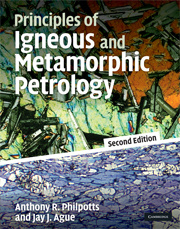Book contents
- Frontmatter
- Contents
- Preface
- Acknowledgments
- List of units
- 1 Introduction
- 2 Physical properties of magma
- 3 Intrusion of magma
- 4 Forms of igneous bodies
- 5 Cooling of igneous bodies and other diffusion processes
- 6 Classification of igneous rocks
- 7 Introduction to thermodynamics
- 8 Free energy and phase equilibria
- 9 Thermodynamics of solutions
- 10 Phase equilibria in igneous systems
- 11 Effects of volatiles on melt equilibria
- 12 Crystal growth
- 13 Isotope geochemistry related to petrology
- 14 Magmatic processes
- 15 Igneous rock associations
- 16 Metamorphism and metamorphic facies
- 17 Deformation and textures of metamorphic rocks
- 18 Graphical analysis of metamorphic mineral assemblages
- 19 Geothermometry, geobarometry, and mineral reactions among solid solutions
- 20 Mineral reactions involving H2O and CO2
- 21 Material transport during metamorphism
- 22 Pressure–temperature–time paths and heat transfer during metamorphism
- 23 Origin of rocks
- Answers to selected numerical problems
- References
- Index
19 - Geothermometry, geobarometry, and mineral reactions among solid solutions
- Frontmatter
- Contents
- Preface
- Acknowledgments
- List of units
- 1 Introduction
- 2 Physical properties of magma
- 3 Intrusion of magma
- 4 Forms of igneous bodies
- 5 Cooling of igneous bodies and other diffusion processes
- 6 Classification of igneous rocks
- 7 Introduction to thermodynamics
- 8 Free energy and phase equilibria
- 9 Thermodynamics of solutions
- 10 Phase equilibria in igneous systems
- 11 Effects of volatiles on melt equilibria
- 12 Crystal growth
- 13 Isotope geochemistry related to petrology
- 14 Magmatic processes
- 15 Igneous rock associations
- 16 Metamorphism and metamorphic facies
- 17 Deformation and textures of metamorphic rocks
- 18 Graphical analysis of metamorphic mineral assemblages
- 19 Geothermometry, geobarometry, and mineral reactions among solid solutions
- 20 Mineral reactions involving H2O and CO2
- 21 Material transport during metamorphism
- 22 Pressure–temperature–time paths and heat transfer during metamorphism
- 23 Origin of rocks
- Answers to selected numerical problems
- References
- Index
Summary
INTRODUCTION
Petrogenetic grids provide a means of setting limits on the temperatures and pressures under which a given mineral assemblage can form, but these limits are commonly rather wide. A rock containing the divariant assemblage garnet + biotite + chlorite could be stable over a temperature range of nearly 100 °C and a pressure range in excess of 0.8 GPa (Fig. 18.14). Many of the minerals constituting these assemblages are solid solutions, and their compositions may vary considerably across a divariant field. We can use these variations to our advantage, however, because the chemical compositions of coexisting minerals are functions of temperature and pressure.
If we can determine how Fe, Mg, and other elements partition themselves between coexisting minerals as pressure and temperature vary, then precise metamorphic temperatures and pressures can be determined from analyses of the minerals. So to extract pressure–temperature information from rocks, the first step is to measure the chemical compositions of the minerals. This is usually done using the electron microprobe, which offers micrometer-scale spatial resolution and the ability to determine major, minor, and many trace elements. Then, the positions of reactions among the minerals in P–T space are calculated using thermodynamic data sets and activity models derived from laboratory experiments and, in some cases, natural mineral assemblages. As we saw earlier in Chapter 9, reactions that are useful for estimating temperatures are called geothermometers, whereas those useful for estimating pressures are called geobarometers.
- Type
- Chapter
- Information
- Principles of Igneous and Metamorphic Petrology , pp. 473 - 489Publisher: Cambridge University PressPrint publication year: 2009



